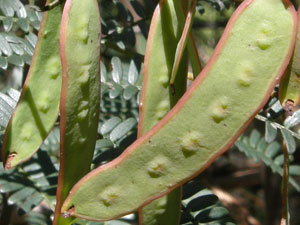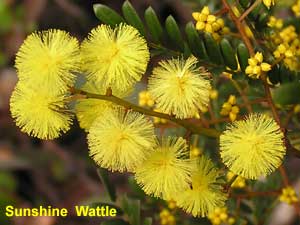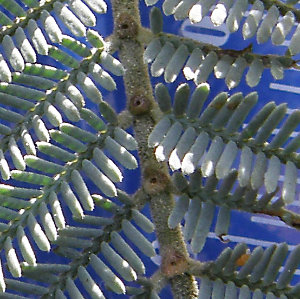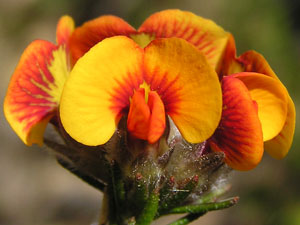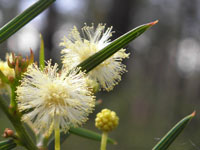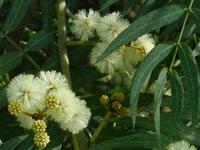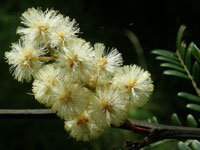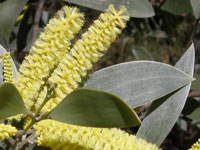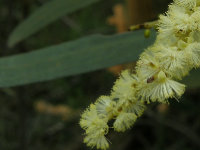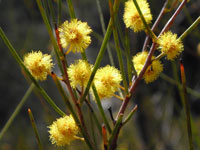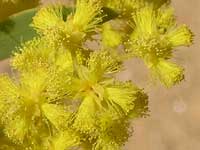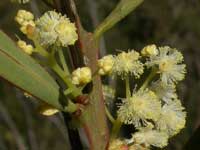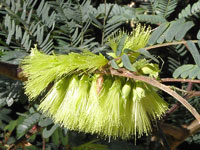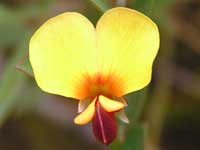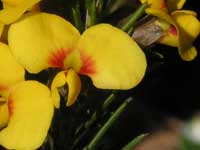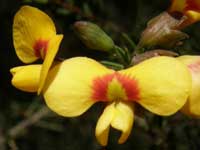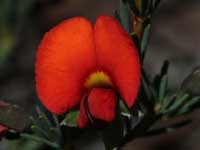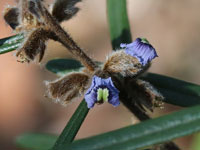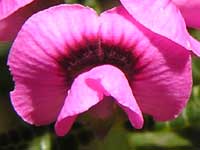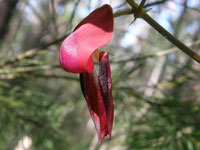We acknowledge the traditional custodians of the land on which these plants grow - the Darug and Gundungurra people - and pay respect to their Elders past, present and emerging.
Note: Images marked as LCNP were taken in the Lane Cove National Park.
Looking at the acacia and peaflower flowers, one can't see the relationship - but the seedpods tell a different story.
There's 700 genera (18,000 species) in the Fabaceae family worldwide - with 180 genera (1,900 species) in Australia.
The Blue Mountains has over 270 species - including introduced species.
The greater Blue Mountains has over 100 Acacia species.
Although the Acacia genus is by far the largest genus in the Mimosoideae subfamily, PlantNET lists a further nine genera in NSW. Of these only the introduced Crested Wattle (Paraserianthes lophantha subsp. lophantha) is found in the Blue Mountains.
The first thing to grasp with most acacias is that the leaf like objects are actually flattened leaf stalks and are called phyllodes. (I find it best to just think of them as leaves.)A key to identifying acacias can be their glands. Acacia flowers do not have nectar. Their glands are known as a nectary and its their secretion that attracts pollinators.
The circular bumps on this image are the glands of a Silver Wattle.
Acacia groups
To simplify searches I have presented the Acacia species in four groups. If a species is in an earlier group, then it won’t be in a later group.
*bipinnate are a second set of leaves on a stem. The image above shows bipinnate leaves which are called pinnules.
There are an estimated 160 species in the Blue Mountains including nearly 40 introduced species (weeds).
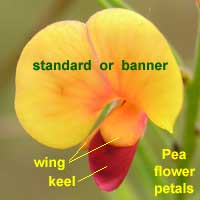
- Acacia asparagoides
- Acacia ptychoclada
- Barradam-bang Wattle
- Blackwood
- Blunt Leaf Wattle
- Box-leaved Wattle
- Coast Myall
- Crested Wattle *
- Flax-leaved Wattle
- Gordon's Wattle
- Heath Wattle
- Hedgehog Wattle
- Acacia asparagoides
- Acacia binervia
- Acacia brownii
- Acacia buxifolia subsp. buxifolia
- Acacia dealbata subsp. dealbata
- Acacia decurrens
- Acacia echinula
- Acacia elata
- Acacia elongata
- Acacia gordonii
- Acacia gunnii
- Acacia juncifolia
- Acacia linifolia
- Acacia longifolia subsp. longifolia
- Acacia lunata
- Acacia meiantha
- Acacia melanoxylon
- Acacia myrtifolia
- Acacia obtusifolia
- Acacia oxycedrus
- Acacia paradoxa
- Acacia ptychoclada
- Acacia rubida
- Acacia suaveolens
- Acacia terminalis subsp. angustifolia
- Acacia terminalis subsp. aurea
- Acacia trinervata
- Acacia ulicifolia
- Paraserianthes lophantha subsp. lophantha *
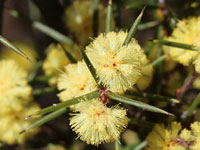
Acacia asparagoides
It’s an uncommon species but can be found in the upper Blue Mountains.
Its flowers are 10mm across and its phyllodes are up to 15mm in length.
It flowers in early spring.
Here's another image and another.
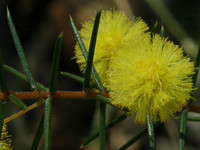
Heath Wattle
Acacia brownii
The phyllodes can be up to 20mm long and there’s fewer of them.
Its bright yellow flowers appear in winter and spring.
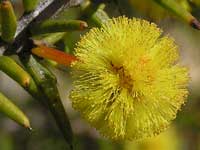
Hedgehog Wattle
Acacia echinula
Its phyllodes can be terete (cylindrical) or 4-angled as shown here.
It flowers from winter into spring.
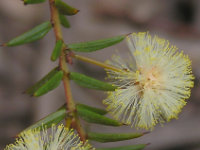
Ploughshare Wattle
Acacia gunnii
Its pale yellow flowers appear from winter into spring.
References mention that it is a very variable species.
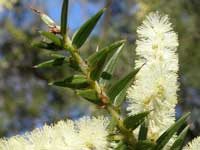
Spike Wattle
Acacia oxycedrus
Its cylindrical flower heads are 2-3cm long.
It’s stunning when in flower in spring and is more likely found in the lower Blue Mountains.
This image shows its opening buds.
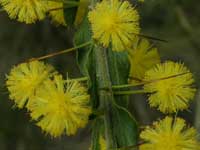
Kangaroo Thorn
Acacia paradoxa
Its bright yellow flowers are 10mm wide and appear in spring.
Although found in the Blue Mountains, these photos were taken in Wollemi NP.
Here's another image and another .
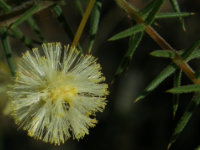
Prickly Moses
Acacia ulicifolia
Its phyllodes are at right angles to the branch, hairy and have a marked gland angle and longer stipules (highlighted in yellow).
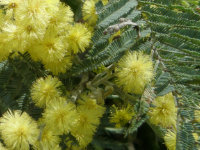
Silver Wattle
Acacia dealbata subsp. dealbata
(jugary - at the junction of pairs of bipinnate stems)
It’s a tree up to 30m in height and flowers from winter into spring.
It’s globular flowers are 10mm across.
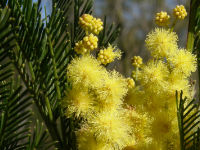
Sydney Green Wattle
Acacia decurrens
It has jugary glands but no interjugary glands.
It flowers mainly in late winter and spring.
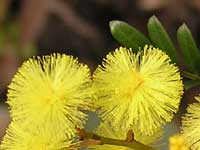
Sunshine Wattle
Acacia terminalis
subsp. aurea
This is the main subspecies found in the upper Blue Mountains.
Here's another image.
NB. The Sunshine Wattle subspecies have been given temporary names while they are reviewed. I have retained the previous name for the present.
- A. terminalis subsp. aurea ➡ A. terminalis subsp. Bright yellow flower (M.Tindale NSW248078)
- A. terminalis subsp. angustifolia ➡ A. terminalis subsp. Glabrous form (M.Hancock 94)
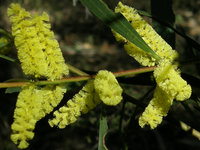
Sydney Golden Wattle
Acacia longifolia subsp. longifolia
The Long Leaf Gall Wasp creates galls on its flowers. Here's another gall image.
A. longifolia subsp. sophorae (Coastal Wattle) has shorter and wider phyllodes.
Here's another image and another.
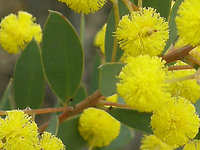
Box-leaved Wattle
Acacia buxifolia subsp. buxifolia
Although found in the Blue Mountains, these photos were taken in Wollemi NP.
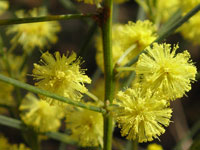
Swamp Wattle
Acacia elongata
It has up to 40 flowers in a globe and flowers from late winter into spring.
Here's another image.
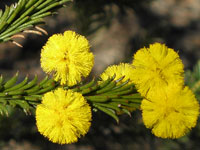
Gordon's Wattle
Acacia gordonii
It is mainly found in the lower Blue Mountains. Here's another image.
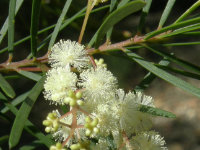
Flax-leaved Wattle
Acacia linifolia
It has a prominent midvein and a mucro.
This leggy tree has less flowers per flower-head which prevents it from having the yellow spheres of the Sunshine Wattle.
Here's another image.
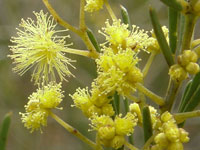
Barradam-bang Wattle
Acacia meiantha
It received its common name, which means "bright star" in the Wiradjuri language, in 2020.
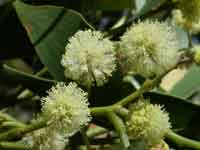
Blackwood
Acacia melanoxylon
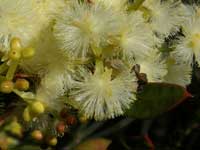
Myrtle Wattle
Acacia myrtifolia
This image shows its opening buds and red stem.
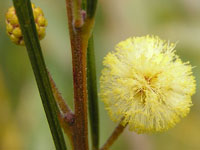
Acacia ptychoclada
It flowers in summer and autumn, and is found in swamps and next to watercourses in the Mid to Upper Blue Mountains.
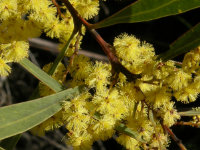
Red-stemmed Wattle
Acacia rubida
Its most striking feature is its abundance of bipinnate leaves on mature growth.
Here's another image and another.
Paraserianthes genus
The Paraserianthes genus only has one species, and it has two subspecies. Paraserianthes lophantha subsp. montana is a native of Western Indonesia.
- African Scurf-pea *
- Australian Indigo
- Broad-leaf Wedge Pea
- Broom Bossiaea
- Clustered Bitter-pea
- Common Hovea
- Creeping Wedge-pea
- Dainty Wedge Pea
- Dense Phyllota
- Dillwynia elegans
- Dusky Coral Pea
- Dwarf Wedge Pea
- Gorse *
- Gorse Bitter Pea
- Halo Bush-pea
- Handsome Flat Pea
- Heath Phyllota
- Heathy Mirbelia
- Heathy Parrot Pea
- Large Wedge Pea
- Large-flowered Mirbelia
- Leafless Globe-pea
- Mirbelia baueri
- Native Holly
- Pultenaea canescens
- Purple Coral Pea
- Red Wedge Pea
- Rhombic Bossiaea
- Rough Bush-pea
- Rusty Pods
- Sandstone Parrot-pea
- Scotch Broom *
- Spiny Bossiaea
- Sword Bossiaea
- Variable Bossiaea
- Winged Bitter Pea
- Bossiaea ensata
- Bossiaea heterophylla
- Bossiaea obcordata
- Bossiaea rhombifolia
- Bossiaea scolopendria
- Cytisus scoparius *
- Daviesia alata
- Daviesia corymbosa
- Daviesia ulicifolia subsp. ulicifolia
- Dillwynia brunioides
- Dillwynia elegans
- Dillwynia retorta
- Gompholobium glabratum
- Gompholobium grandiflorum
- Gompholobium inconspicuum
- Gompholobium latifolium
- Gompholobium minus
- Gompholobium uncinatum
- Hardenbergia violacea
- Hovea linearis
- Hovea longifolia
- Indigofera australis subsp. australis
- Kennedia rubicunda
- Mirbelia baueri
- Mirbelia platylobioides
- Mirbelia rubiifolia
- Phyllota grandiflora
- Phyllota squarrosa
- Platylobium formosum
- Podolobium ilicifolium
- Psoralea pinnata *
- Pultenaea canescens
- Pultenaea linophylla
- Pultenaea scabra
- Sphaerolobium minus
- Ulex europaeus *
There's 78 Bossiaea species - all endemic to Australia - with 10 recorded as being in the Blue Mountains.
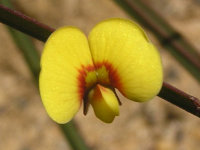
Sword Bossiaea
Bossiaea ensata
Its flat strap-like branches are 4-5mm wide; the flowers 10mm across.
It has a green keel and the back of its standard is red.
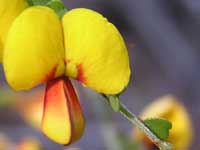
Spiny Bossiaea
Bossiaea obcordata
Its spines announce its presence.
The heart-shaped folded leaves and hairy branchlets confirm its identity.
Its keel is dark red.
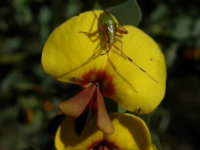
Rhombic Bossiaea
Bossiaea rhombifolia
But its roundish alternate leaves make it stand out.
Here's another image of its leaves.
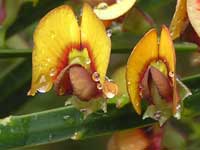
Broom Bossiaea
Bossiaea scolopendria
Similar to B. ensata but B. scolopendria has reddish wings and the flowers are larger. And unlike B. ensata its branches aren't smooth.
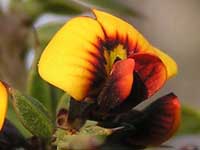
Gorse Bitter Pea
Daviesia ulicifolia subsp. ulicifolia
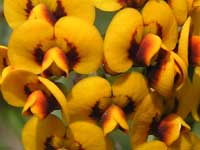
Clustered Bitter-pea
Daviesia corymbosa
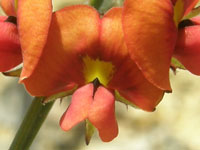
Winged Bitter Pea
Daviesia alata
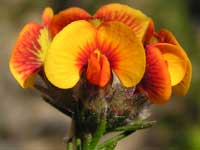 Sandstone Parrot-pea
Sandstone Parrot-pea
Dillwynia brunioides
Here's another image that shows the more usual spreading leaves.
There's 11 species of Gompholobium in NSW - 10 of which can be found in the Blue Mountains.
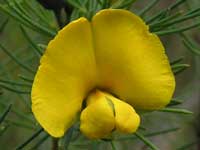
Large Wedge Pea
Gompholobium grandiflorum
The flowers are 20mm wide.
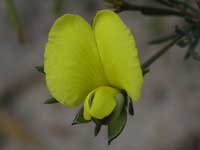
Dainty Wedge Pea
Gompholobium glabratum
Here's another image.
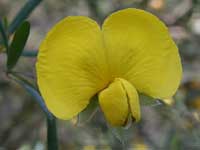
Broad-leaf Wedge Pea
Gompholobium latifolium
Growing up to 3 metres in height, it is the largest of the Wedge Peas.
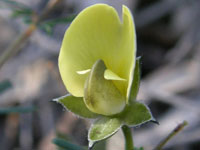
Dwarf Wedge Pea
Gompholobium minus
Its flowers are 7mm wide.
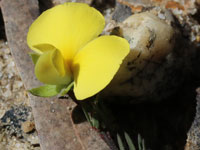
Creeping Wedge-pea
Gompholobium inconspicuum
Here's another image.
There's 20 species of Hovea in NSW - 8 of which can be found in the Blue Mountains.
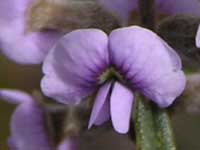
Common Hovea
Hovea linearis
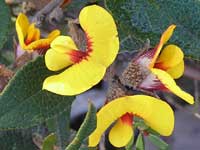
Large-flowered Mirbelia
Mirbelia platylobioides
The flower is 10-12mm wide.
Here's another image. [Note: The name "Large-flowered Mirbelia" is not commonly accepted.]
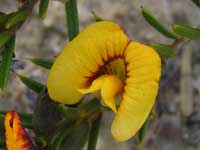
Mirbelia baueri
Here's another image.
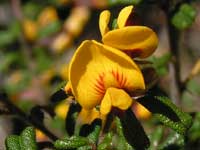
Rough Bush-pea
Pultenaea scabra
[Stipules are the small leafy growth at the base of leaves.]
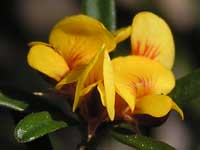
Halo Bush-pea
Pultenaea linophylla
Its leaves are 10mm long, have a down-turned tip and are hairy underneath.
It is also known as the Small-leaved Bush-pea.
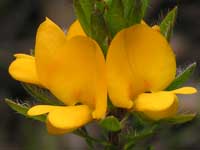
Pultenaea canescens
There's 4 species of Phyllota in NSW - 3 of which can be found in the Blue Mountains.
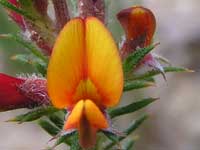
Dense Phyllota
Phyllota squarrosa
Its elongated standard is 8mm high, and its leaf margins revolute (rolled-back).
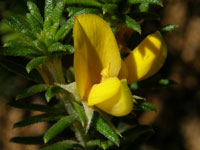
Heath Phyllota
Phyllota grandiflora
The densely villous (hairy) calyx shows it to be P. grandiflora.
Here's another image.
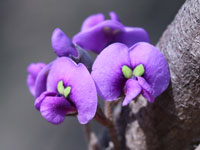
Purple Coral Pea
Hardenbergia violacea
Its flowers are 8mm across. Commercially it is known as the Happy Wanderer.
Here's an image of its leaves.
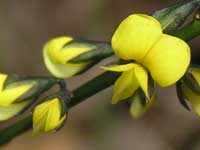
Leafless Globe-pea
Sphaerolobium minus
The flowers are barely 5mm wide and long.
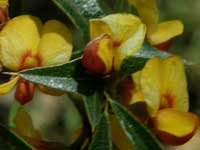
Native Holly
Podolobium ilicifolium
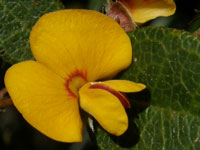
Handsome Flat Pea
Platylobium formosum
The back of the standard is red.
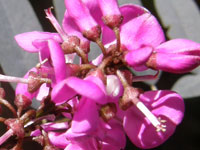
Australian Indigo
Indigofera australis subsp. australis
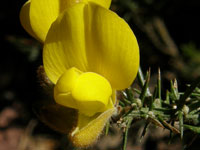
Gorse
Ulex europaeus
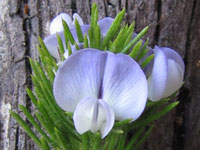
African Scurf-pea
Psoralea pinnata
It can grow to 5m in height.
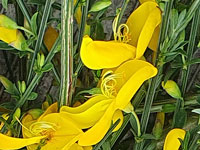
Scotch Broom
Cytisus scoparius
Its five-ribbed branches identify it.
Here's another image.

